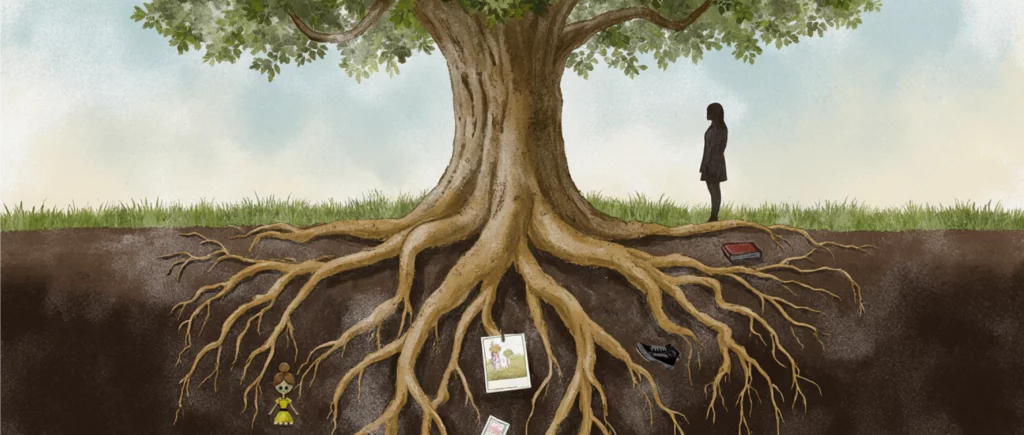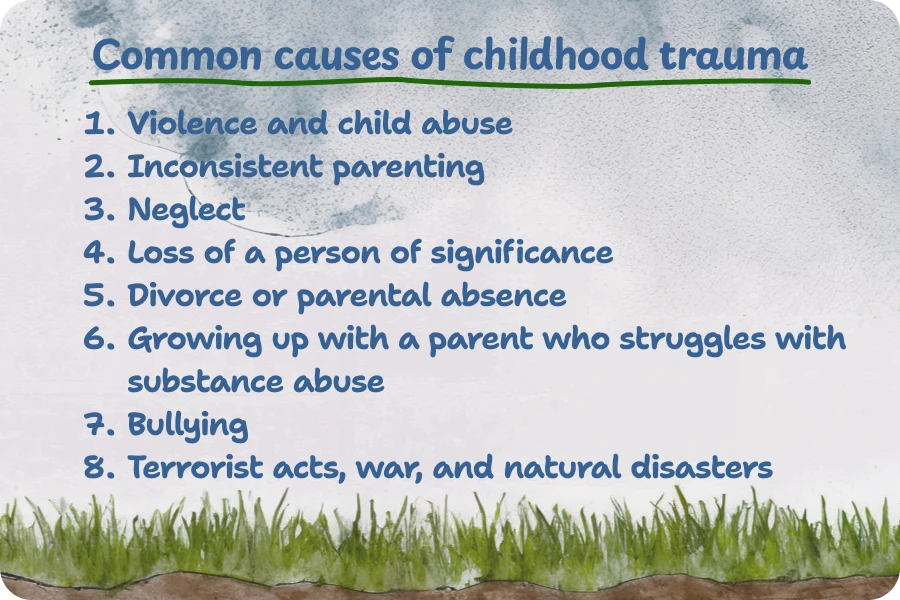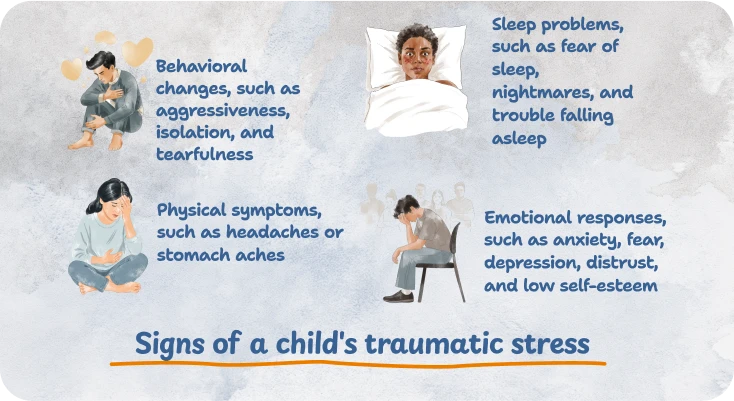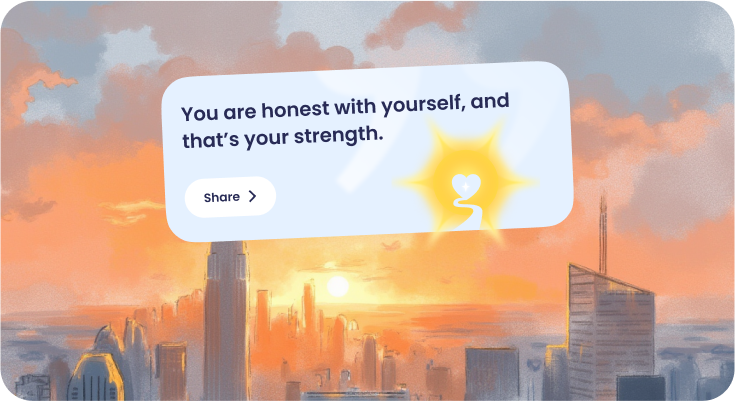Have you ever felt like your reactions to stress are stronger than they should be? Have you ever wondered why it’s hard to trust or feel safe around others? All these thoughts and emotions may be mental health outcomes of childhood trauma.
Research suggests that over two-thirds of people experience at least one traumatic event before turning 16 [1]. Those things can overwhelm us and make us feel we have no sense of safety or control. In this case, even seemingly ordinary moments in childhood lay the groundwork for the early childhood trauma that can subtly shape our adult lives.
If you’ve ever wondered whether your adult struggles have roots in childhood, let’s explore what trauma is, how it happens, and the path to dealing with childhood trauma.
What Is Childhood Trauma or ACEs?
Childhood trauma is an event or experience that causes significant emotional distress under the age of 18 and can cause negative physical and mental health outcomes, affecting a person’s behavior and development.
It can result from abuse, neglect, loss of a person of significance, parental divorce or absence, domestic violence, bullying, household substance abuse, or exposure to war and natural disasters. At its core, childhood trauma often arises because the child feels powerless and unable to protect themselves in a difficult or threatening situation.
Early childhood trauma can have consequences that can show up immediately after the traumatic stress or several years later. Research from 2018 suggests that traumatic events in childhood are connected with a number of mental health conditions, such as schizophrenia, bipolar disorder, borderline personality disorder, major depressive disorder, and complex trauma (c-PTSD) [2].
If you want to better understand yourself, Breeze offers a variety of self-discovery tests to explore your attachment style, emotional intelligence level, and temperament, uncover your mental age, or determine how likable you are, and many more.
What Is the Difference Between Trauma And Stress?
In short, stress is a temporary response to pressure, while trauma is a deeper wound caused by overwhelming stress that they couldn’t cope with.
Stress is the body’s natural reaction to challenges or pressure. It can be positive, helping you stay alert and motivated, or negative, causing worry, tension, or fatigue. Stress usually fades once the situation improves or you find ways to cope.
Trauma, on the other hand, comes from experiencing or witnessing deeply distressing or life-threatening events and ongoing experiences, such as childhood abuse or living in poverty. Unlike stress, trauma overwhelms a person’s ability to cope and can leave lasting effects on emotions, thoughts, and behavior.

Common Causes And Examples of Childhood Trauma
These are the most common causes and examples of childhood trauma:
1. Violence and child abuse
Here are examples of childhood abuse:
- Physical abuse: hitting, beating, or any form of physical harm.
- Emotional abuse: constant criticism, humiliation, or verbal attacks.
- Sexual abuse: inappropriate touching, exploitation, or exposure.
Have you ever experienced child abuse?
2. Inconsistent parenting
This situation is typical for children of narcissistic parents who can be inconsistent in their parenting, swinging between over-involvement and neglect, ignoring or dismissing the child’s feelings.
For instance, the inconsistent parent might get upset about something minor, like the child not doing their homework. They may act like nothing happened a few minutes later, showing love or asking about the child’s day at school.
Alternatively, after a period of silent treatment, the parent may suddenly become extremely affectionate, confusing the child and making it difficult to tell the difference between manipulation and true concern. Such unpredictable behaviors can make the child feel worthless and confused, wondering how to act to avoid anger or disappointment.
3. Neglect
Examples of childhood neglect can be the following:
- Physical neglect: not providing food, a safe place to live, or proper care.
- Emotional neglect: ignoring a child’s need for love, support, or attention.
In homes where parents’ emotional states swing unpredictably, children often need to become little adults, managing not only their own feelings but also those of their parents.
4. Loss of a person of significance
A loss becomes especially traumatic for a child because they don’t yet have the emotional tools or life experience to process grief. When someone important disappears suddenly, the child often feels abandoned, unsafe, and powerless. They may not understand why it happened, and this confusion can easily turn into anger or guilt.
A child may ask themselves, “Was it my fault?” or “Why am I always angry and irritated for no reason?” They can also be left with questions about why the person chose to leave and whether they could have done something to prevent it, falling into a shame spiral. These can continue through adulthood. For example, a child who loses a parent in an accident may grow up fearing that everyone they care about will eventually leave them, feeling constant anxiety about loved ones’ safety.
5. Divorce or parental absence
For a child, feeling like an orphan despite having living parents can be just as traumatic as the loss of a significant adult. A child often feels abandoned, confused, and guilty, wondering if they caused the separation. Without proper parental support, these feelings can sink deep and shape how the child sees themselves and their relationships in adulthood.
6. Growing up with a parent who struggles with substance abuse
In families where substance abuse is present, a child often grows up in an atmosphere of unpredictability and fear. They may feel unsafe, anxious, or constantly on guard, never knowing what mood their parent will be in.
This instability forces the child to adapt too early, sometimes taking on adult responsibilities like caring for siblings or even the parent, instead of having a carefree childhood. Over time, the child may learn to suppress their own emotions to avoid conflict, disconnect from their feelings, or even forget large parts of their childhood as a way of protecting themselves from pain [9].
7. Bullying
Bullying is repeated aggressive behavior, such as teasing, hitting, or exclusion, intended to hurt or intimidate someone. A child who is bullied may feel scared, worthless, isolated, and anxious, which can harm their self-esteem and emotional development. At the same time, bullying can make a person hostile towards others, starting a cycle of bullying.
8. Terrorist acts, war, and natural disasters
For example, a child who witnessed a bombing during a terrorist attack in their community might feel unsafe in crowded places as an adult, avoiding concerts, malls, or public transport, wondering, “Why am I so sensitive?”

Developmental Trauma vs. Post-Traumatic Stress Disorder (PTSD)
Developmental trauma is chronic and happens during formative years, shaping long-term emotional and relational patterns, while posttraumatic stress disorder can develop from a single or repeated traumatic event at any age. Here are the key differences:
Developmental Trauma:
- Occurs in childhood, often over a long period.
- Caused by ongoing neglect, abuse, or a household with dysfunctional family roles.
- Affects brain development, attachment, and emotional regulation.
- Symptoms may include emotional dysregulation and difficulty trusting others and building relationships.
- Can lead to complex PTSD (CPTSD) in adulthood, which involves prolonged emotional distress, negative self-perception, and difficulties in relationships.
PTSD:
- Can occur at any age after a single or repeated traumatic event.
- Triggered by events such as accidents, assaults, natural disasters, or war.
- Symptoms include flashbacks, nightmares, hypervigilance, and avoidance behaviors.
- It is often easier to identify because it follows a specific event, unlike developmental trauma, which builds over time.
Signs & Symptoms of Childhood Trauma
In some cases, unresolved childhood trauma doesn’t just affect psychological well-being: it can have physical effects, too:
Signs in Children
If you notice these signs of experienced trauma in your child, it may be helpful to seek help from a mental health professional who can help recognize and treat traumatic stress.
Behavioral Signs
- Sudden changes in behavior or mood
- Withdrawal from friends, family, or activities
- Aggression or frequent outbursts
- Difficulty concentrating at school
- Regressive behaviors like bedwetting or thumb-sucking
Emotional Signs
- Excessive fear or anxiety
- Guilt or shame without a clear cause
- Low self-esteem or feelings of worthlessness
- Difficulty trusting adults or peers
- Emotional numbness or detachment
Physical Signs
- Changes in sleep patterns (nightmares, insomnia)
- Frequent headaches or stomachaches with no medical cause
- Unexplained injuries or signs of neglect
- Fatigue or low energy
Social Signs
- Difficulty forming or maintaining friendships
- Avoidance of social situations or school
- Clinginess to caregivers or constant need for reassurance
Signs in Adult Survivors
Here’s a list of common signs of adults’ childhood trauma:
Emotional Signs
- Persistent anxiety or fear
- Mood changes or irritability
- Feelings of guilt, shame, or low self-worth
- Difficulty trusting others
- Emotional numbness or detachment
Behavioral Signs
- Avoidance of certain people, places, or situations
- Difficulty maintaining healthy relationships
- People-pleasing or controlling behaviors
- Impulsive or self-destructive habits
- Struggles with anger management
Cognitive Signs
- Difficulty concentrating or making decisions
- Intrusive thoughts or flashbacks related to past trauma
- Negative self-talk or constant self-criticism
Physical Signs
- Chronic stress symptoms like headaches, stomach issues, or fatigue
- Insomnia or nightmares
- Frequent illness due to a weakened immune response

Childhood Post-Traumatic Stress Disorder Symptoms
Not everyone is affected by childhood trauma to the same degree. For example, you might find that you experience the symptoms above only rarely or only in certain situations. Post-traumatic stress disorder (PTSD) is a stronger manifestation of trauma with the following symptoms:
- Emotional distress and difficulty in accomplishing daily activities
- Hypervigilance and avoidance behaviors
- Emotional emptiness and numbness
- Feelings of depression and anxiety
- Negative self-perception or self-loathing
- Unbalanced emotional attachment
- Dissociation amnesia or dissociative disorders, like depersonalization
- Eating disorders
- Birthday depression
- Addictive behaviors and substance abuse
How Childhood Trauma Impacts Adulthood
Let’s look at some examples of how different types of childhood trauma can show up in adulthood:
1. Cognitive impairments
Physical, sexual, economic violence against children, or emotional abuse disrupts vital brain and nervous system growth, impacting lifelong physiological functions. The consequences of childhood abuse include cognitive impairments like difficulties with attention, concentration, or learning, memory issues, and poor problem-solving and decision-making. These impairments may prevent educational and professional achievement.
2. Continuation of an abuse cycle
What’s more, violence tends to perpetuate, with children exposed to abuse more likely to become abusers or experience a further abuse cycle with trauma bonding. However, releasing childhood trauma can help break that cycle.
3. Perfectionism & an inferiority complex
Childhood trauma may also lead to perfectionism and an inferiority complex. Family role patterns and birth order can have a similar impact. Middle Child Syndrome may leave a child feeling invisible or less valued compared to their siblings. This, in turn, can cause insecurity or a constant need to prove themselves.
For example, growing up, Sarah faced constant criticism and high expectations from her parents. Her overprotective and controlling parents limited her freedom to develop her ideas and often compared her unfavorably with her high-achieving brother, which increased her feelings of inferiority.
As a grown-up, Sarah always aims to be perfect and fears anyone seeing her as anything less. She ends up micromanaging everything to make up for what she thinks she lacks. This creates stress and makes it hard for her to trust or let others help. A vicious circle of thoughts, “Why am I so insecure?” and need to control everything, makes it difficult for her to form trusting relationships.
4. Parentification trauma
In some families, parenting can be inconsistent, leaving children feeling insecure and uncertain. Parentification, according to research on problem behavior of adolescents, happens when roles in the family are reversed and a child becomes a caretaker to emotionally immature parents [3].
This early responsibility can plant deep roots of trauma that often extend into adulthood, affecting relationships, emotional regulation, and self-esteem. Another example is Eldest Daughter Syndrome, when the burden of responsibility and caretaking in the family is placed on the oldest girl, which makes her vulnerable to stress, guilt, and suppressed emotional needs.
5. Perfectionism & superiority complex
On the other hand, some children experience the opposite extreme, being consistently praised. This, in turn, may lead to a superiority complex in adulthood. For example, Glass Child Syndrome describes children who grew up, often feeling pressured to be “perfect.”
For instance, growing up, Joseph was placed on a pedestal, believing he was better than everyone else. As an adult, he struggles to maintain control and assert himself. He finds it difficult to accept criticism, accept the views of others, and cooperate, wondering, “Why does nobody like me?”. This also prevents him from undergoing childhood trauma therapy for adults.
6. Difficulties setting boundaries
Being neglected, the child learns to suppress their needs to keep the parent satisfied, often becoming hyper-responsible, overly self-critical, and prone to anxiety. In adulthood, this may show up as difficulty setting boundaries, fear of disappointing others, or feeling guilty for prioritizing their own well-being. Sometimes, when parents also don’t know how to respect a child’s boundaries, it makes them develop enmeshment trauma.
7. Victim complex
Neglect may also lead to a victim complex. For example, as a child, Alexis was often told, “Stop crying,” “Don’t be angry, just forget it,” or “Do it yourself.” This constant neglect and dismissal of her emotional or physical needs made her feel like a failure.
Now an adult, Alexis constantly seeks validation and reassurance from others and perceives herself as a victim. She believes the world is totally against her and feels helpless in the face of negative events, which she attributes solely to external forces.
8. Abandonment issues
Experiencing the sudden or violent loss of a loved one during the early years can also be profoundly traumatic and lead to abandonment trauma. Typically, experiencing a loss can lead to a deep fear of loneliness in adulthood.
As an illustration, Elizabeth spent her early childhood in a warm and loving family. Unfortunately, a tragic accident changed everything when her father passed away. Elizabeth felt abandoned without her father’s love and with her mother’s withdrawal into depression.
With no parent to support her emotionally, she developed an insecure attachment style. Today, Elizabeth has a profound fear of solitude as a place where there is no one to support or comfort her. She hates spending time alone, feeling unmotivated to do anything, and desperately seeks companionship to avoid feeling lost.
9. Attachment trauma
When emotional closeness is lacking, it can lead to attachment trauma. Children may develop different patterns, such as anxious attachment, feeling clingy and fearing abandonment; avoidant attachment, suppressing emotions and keeping distance; or disorganized attachment, showing confusion and fear in relationships.
Children who have experienced parental divorce and developed these patterns may later have trust issues, fear of intimacy, and hyper-independence, which impacts their ability to form deep connections.
For example, a child who grew up with one parent emotionally absent after divorce may learn to rely only on themselves. As an adult, they might avoid vulnerability in relationships out of fear of being abandoned again, wondering, “Why do I push people away?”.
10. Negative thought patterns
Research on bullying shows that it often comes from feeling threatened, like thinking, “Why do I hate everyone?” or “Why is everyone so mean to me?” and feeling the urge to protect yourself first [11]. As a result, it can make a person experiencing bullying develop negative thought patterns and act aggressively in social situations to feel like they’re in control in adulthood.
11. Higher risk of mental health conditions and substance abuse
According to research on childhood trauma, childhood exposure to natural disasters, terrorism, armed conflict, or forced displacement leads to higher chances of anxiety, depression, post-traumatic stress disorder, difficulties in forming and maintaining relationships, and a higher risk of engaging in self-destructive behaviors in adulthood [4,5].
Surviving traumatic events, like being exposed to substance abuse, may also lead to an increased vulnerability to anxiety and depression, persistent stress, and difficulty in forming healthy relationships [6,7]. People from such backgrounds may also struggle with emotional regulation, which leads to impulsivity and emotional instability. In addition, the likelihood of developing substance abuse in adulthood is notably higher for those who witnessed it during childhood [8].
12. Social anxiety, somatic symptoms, and sleep problem
The emotional impact of bullying also shows up as increased risks of depression, anxiety, alcohol, and substance misuse among those targeted. A child repeatedly mocked for appearance or abilities may grow into an adult with social anxiety or self-doubt. Cyberbullying, in particular, has strong associations with depression, anxiety, low self-esteem, and somatic symptoms [12].
Victims of bullying often show physical symptoms like headaches and chronic pain. Research on bullied children has found that they show a two-fold increase in somatic symptoms and sleep problems compared to their non-bullied peers [10].
13. Self-harm and suicidal behavior
Childhood abuse or witnessing interpersonal violence in the family is linked to anxiety, depression, self-harm or suicidal thoughts, as well as substance abuse and high-risk sexual activity later in adulthood. It also increases the risk of suicide. Most concerning is the link between bullying and self-harm, with a significantly higher level of suicidal thoughts and attempts reported among bullying victims [12].
If you found yourself relating to any of these stories while reading, you may well be dealing with the consequences of your own childhood trauma. Take a test to get insights, recover from childhood trauma, and achieve greater well-being.
How To Heal From Childhood Trauma
Once you become aware of a connection between a traumatic childhood experience and your present state, it’s time to consider mental health services. The reason is that traumatic experiences can have a profound impact on a person’s mental health and may require specialized therapy. A professional can make an assessment and develop an individualized treatment plan.
Here’s how to work on yourself to process your emotions:
1. Allow yourself to experience whatever comes up when you revisit your memories
You might have moments of deep sorrow, anger, and confusion, or even experience unexpected moments of joy as you realize your strength and resilience. Sometimes you may wonder, “Why can’t I cry?” or, on the contrary, think about how to stop crying. Understand that all these feelings are valid and can help you heal from trauma.
2. Release emotions through journaling
Here’s a simple exercise on how to cope with your emotions using journaling:
- Name what you feel. Identify and acknowledge the emotions you’re experiencing. Sincerely ask yourself, “Why am I so emotional lately?” and write it on paper. Let your thoughts flow without censoring yourself.
- Accept these emotions without judgment or suppression, recognizing their role in your healing. For example, it’s normal to feel angry if your trauma is related to a violation of your personal boundaries.
- Let it go using physical release. Sometimes emotions feel stuck in the body. Stand up, stretch, shake out your hands, or do a few deep breaths while thinking about the emotion you’re releasing.
With Breeze journaling, you can write down your emotions daily, track patterns, and reflect on your progress. The app allows you to revisit previous entries, helping you understand triggers and notice improvements. Try to combine regular journaling with Breeze personalized routines, mindful breathing techniques, and self-compassion practices to create a safe space for you to process emotions and gradually release the weight of childhood trauma.

3. Practice affirmations and self-compassion
Replace negative self-talk with positive affirmations to develop a kinder, more compassionate relationship with yourself. For example:
- I am safe in my body and in my relationships.
- My past does not define my future.
- I can trust myself to make good choices.
- It’s safe for me to feel my emotions and release them.
- I have the right to set boundaries that protect my well-being.
Breeze daily affirmations offer prompts you can repeat each morning or throughout the day. Over time, these small reminders help rebuild your thinking patterns, reduce self-criticism, and strengthen emotional resilience.

4. Reconnect with your inner child
The goal of this practice is to compensate for the love and support you needed but might not have received at the time of the traumatic event.
Imagine revisiting the experience you’re healing from, and imagine your younger self meeting your present adult self. Engage in a dialogue, embrace your child with a hug, and offer comfort.
Here are some additional healing childhood trauma techniques to consider:
- Guided imagery and visualization. For example, you might visualize yourself in a safe, comforting place where you can meet and interact with your inner child.
- Educating yourself about trauma can be empowering. Books on childhood trauma, articles, and trusted online resources can help you understand your experiences, learn how to feel your feelings, and get strategies for healing.
- Art therapy. Drawing, painting, sculpting, dancing, and singing can all help you reconnect with your inner child through creativity and imagination.
5. Surround yourself with people who are empathetic and trustworthy
Sharing your feelings with supportive friends, family, or support groups can reduce feelings of isolation and shame.
Expert Insight
Coping with childhood trauma often involves creating a sense of safety and stability in the present, while gradually processing past experiences. Techniques such as grounding exercises, mindfulness, and somatic awareness help regulate emotions and reduce flashbacks or anxiety. Therapy approaches like EMDR and trauma-focused CBT are supportive for processing painful memories safely. Building supportive relationships is crucial in helping to repair the sense of trust and agency that trauma can disrupt.
Rychel Johnson
Mental health professional
How to Support a Child with Early Childhood Trauma
Even if a child has experienced trauma, they can be helped to cope with it and find a way to live a fulfilling life. This may include the following:
- Be patient and empathetic with your child. Encourage them to talk about their feelings with simple phrases like, “It’s okay to feel that way.” Accept their thoughts without judgment, even if they differ from your perspective.
- Create a stable routine and a predictable schedule for meals, bedtime, and school activities to make the child feel safe.
- Regularly reassure the child that they are loved and cared for. You may hug them, hold hands, or say verbal affirmations like “I’m here for you”, “You are safe”, or “I love you no matter what”.
- Encourage your child to be creative. Help them express feelings through art, writing, or play. Activities like drawing, storytelling, or role-playing allow them to process emotions safely.
- Teach them coping techniques like deep breathing, mindfulness activities, or grounding techniques. These skills can help children manage overwhelming emotions.
- Encourage positive relationships with their peers and adults, and the development of social and communication skills.
- Seek professional help when needed. If trauma symptoms persist, interfere with daily life, or worsen over time, involve a child therapist or counselor trained in trauma-informed care.
When to Seek a Mental Health Professional’s Help
Sometimes, you might know what you’re feeling but can’t cope with it alone. How do you get over childhood trauma in that case? This is where professional support can help.
Expert Insight
It’s important to seek professional help when past experiences interfere with daily life, relationships, or emotional well-being. If you’re consistently depressed, anxious, and having difficulty trusting others, therapy can help you get “unstuck” from patterns holding you back. Even if symptoms feel manageable, therapy can provide a safe space to process trauma and build coping skills before challenges escalate.
Rychel Johnson
Mental health professional
Sources
- Copeland WE, Keeler G, Angold A, Costello EJ. Traumatic events and posttraumatic stress in childhood. May 2007
- Devi F, Shahwan S, Teh WL, Sambasivam R, Zhang YJ, Lau YW, Ong SH, Fung D, Gupta B, Chong SA, Subramaniam M. The prevalence of childhood trauma in psychiatric outpatients. August 2019.
- Van Loon, L. M., Van de Ven, M. O., Van Doesum, K. T., Hosman, C. M., & Witteman, C. L. (2017). Parentification, Stress, and Problem Behavior of Adolescents who have a Parent with Mental Health Problems. July 2015
- Makwana N. Disaster and its impact on mental health: A narrative review. October 2019.
- Bürgin D, Anagnostopoulos D; Board and Policy Division of ESCAP; Vitiello B, Sukale T, Schmid M, Fegert JM. Impact of war and forced displacement on children’s mental health-multilevel, needs-oriented, and trauma-informed approaches. June 2022
- Meulewaeter F, De Pauw SSW, Vanderplasschen W. Mothering, Substance Use Disorders and Intergenerational Trauma Transmission: An Attachment-Based Perspective. October 2019
- Khoury L, Tang YL, Bradley B, Cubells JF, Ressler KJ. Substance use, childhood traumatic experience, and Posttraumatic Stress Disorder in an urban civilian population. December 2010
- Margret Torshamar Georgsdottir, Sigrun Sigurdardottir, Hrafnhildur Gunnthorsdottir. “This Is the Result of Something Else”: Experiences of Men That Abused Drugs and Had Experienced Childhood Trauma. April 2021
- Otgaar H, Howe M, Patihis L et al. The return of the repressed: The persistent and problematic claims of long-forgotten trauma. October 2019
- Gini G, Pozzoli T. Bullied children and psychosomatic problems: a meta-analysis. October 2013
- Susan M. Swearer, Shelley Hymel. Understanding the Psychology of Bullying. May–June 2015
- Nixon CL. Current perspectives: the impact of cyberbullying on adolescent health. August 2014
- De Bellis MD, Zisk A. The biological effects of childhood trauma. April 2014
Disclaimer
This article is for general informative and self-discovery purposes only. It should not replace expert guidance from professionals.
Any action you take in response to the information in this article, whether directly or indirectly, is solely your responsibility and is done at your own risk. Breeze content team and its mental health experts disclaim any liability, loss, or risk, personal, professional, or otherwise, which may result from the use and/or application of any content.
Always consult your doctor or other certified health practitioner with any medical questions or concerns
Breeze articles exclusively cite trusted sources, such as academic research institutions and medical associations, including research and studies from PubMed, ResearchGate, or similar databases. Examine our subject-matter editors and editorial process to see how we verify facts and maintain the accuracy, reliability, and trustworthiness of our material.
Was this article helpful?






